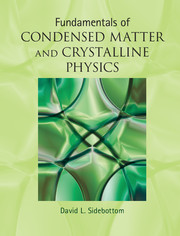 Fundamentals of Condensed Matter and Crystalline Physics
Fundamentals of Condensed Matter and Crystalline Physics from Part I - Structure
Published online by Cambridge University Press: 05 August 2012
Introduction
In the previous chapter, we saw how the long-range order of particle positions in a crystal could be described in a rather elegant manner using a space lattice that extends indefinitely. In this chapter, we examine instead disordered matter such as liquids or glasses in which a long-range repeated pattern is absent. These amorphous materials might not seem as glamorous as their crystalline counterparts, but they are increasingly prevalent in our world as they comprise the windows, computer screens and vast array of plastic components that surround us on a daily basis. In comparison with crystalline structures, these amorphous materials pose a challenge to describe, and their structure can only be defined in a statistical sense by introducing an ensemble-averaged, pair distribution function. In spite of their disordered nature, a robust pattern of particle positions emerges over short distances. This short-range order reflects the local coordination of particles and we briefly review the random close pack and the continuous random network systems as common examples of amorphous structure.
A statistical structure
Disordered or amorphous condensed matter has a clear disadvantage in that particle positions lack any long-range repeating pattern akin to that found in crystals. This is evident in Fig. 2.1, which illustrates the typical particle positions of either a glass or a liquid captured at a particular instant in time.
To save this book to your Kindle, first ensure [email protected] is added to your Approved Personal Document E-mail List under your Personal Document Settings on the Manage Your Content and Devices page of your Amazon account. Then enter the ‘name’ part of your Kindle email address below. Find out more about saving to your Kindle.
Note you can select to save to either the @free.kindle.com or @kindle.com variations. ‘@free.kindle.com’ emails are free but can only be saved to your device when it is connected to wi-fi. ‘@kindle.com’ emails can be delivered even when you are not connected to wi-fi, but note that service fees apply.
Find out more about the Kindle Personal Document Service.
To save content items to your account, please confirm that you agree to abide by our usage policies. If this is the first time you use this feature, you will be asked to authorise Cambridge Core to connect with your account. Find out more about saving content to Dropbox.
To save content items to your account, please confirm that you agree to abide by our usage policies. If this is the first time you use this feature, you will be asked to authorise Cambridge Core to connect with your account. Find out more about saving content to Google Drive.